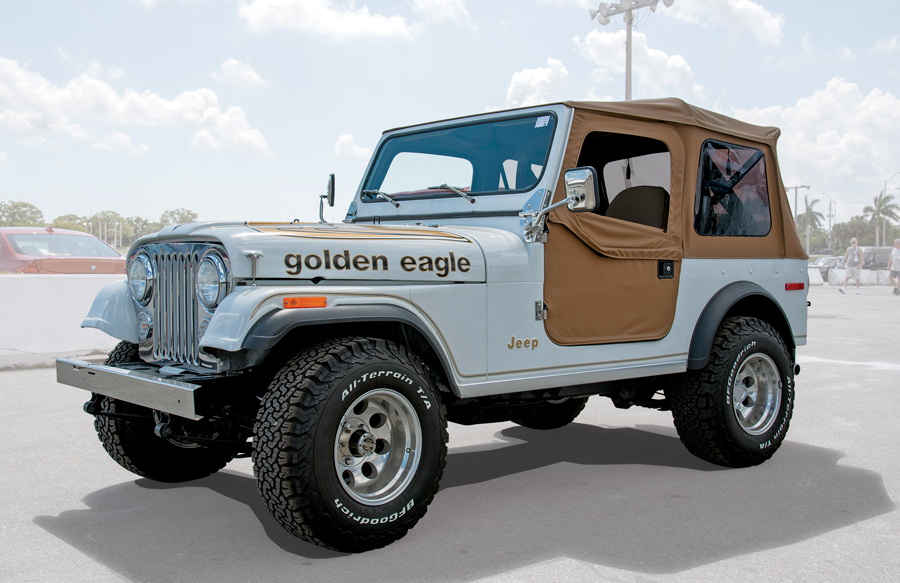- 304-cubic-inch V8 engine
- Manual gearbox
- Fresh restoration, including new paint, interior, soft top and doors, and new wheels with mud tires
SCM Analysis
Detailing
| Vehicle: | 1978 Jeep CJ-7 Golden Eagle |
| Years Produced: | 1977–83 |
| Number Produced: | 379,659 (all CJ-7) |
| Original List Price: | $5,195 |
| SCM Valuation: | $16,500 |
| Tune Up Cost: | $200 |
| Chassis Number Location: | Plate on firewall near master cylinder |
| Engine Number Location: | Tag screwed to passenger’s side valve cover |
| Alternatives: | 1966–77 Ford Bronco, 1973–87 Chevrolet Blazer, 1971–80 International Scout II |
| Investment Grade: | D |
This Jeep, Lot 162, sold for $25,300, including buyer’s premium, at Barrett-Jackson’s Palm Beach, FL, auction on April 11, 2019.
With every new model and each passing year, Jeep seemingly forsakes its rough-and-tumble utilitarian heritage with increasingly plush lines of 4x4s.
This is in order to appeal to a broader, more comfort-minded clientele — one that wants to appear sporty but in actuality just desires a cushy, powerful and distinctive daily driver.
We needn’t look any farther back in time than to the CJ-7 Golden Eagle special edition for a perfect example of Jeep’s early brand perversion.
Gold bird on the hood
Upon the Golden Eagle’s debut in 1977, with its power features and side steps, I imagine good-ole-boy Jeep purists spat in the dirt in disgust. Meanwhile, I picture the entire population of Aspen, CO, throwing their hands in the air with jubilation.
This was not a Jeep for bubbas and mud boggers, after all, but rather for ski instructors and stewardesses.
While the Golden Eagle started with the CJ-5 in 1977, the switch to the CJ-7 platform gave it softer suspension and an elongated wheelbase. What Jeep designers did to the archetypal 4×4 to complete its Golden Eagle transformation would forever shock and appall purists.
AMC’s 304 cubic-inch V8 — the revolutions of which a driver could monitor from the factory-installed tachometer — was fitted beneath the Golden Eagle-decal-festooned hood.
The 5.0-liter 304 featured a cast-iron block and five main bearings with an 8.4:1 compression ratio. The most prodigious variants of the CJ’s 304 V8 — between 1972 and 1978 — churned out 150 horsepower and 245 foot-pounds of torque.
Power disc brakes and power steering were added to the Golden Eagle as well. Side steps for those who wanted to more easily enter their CJ-7 were bolted up. And either a soft- or hard-top roof was offered, both of which kept in the cool breeze that pumped out of a factory air-conditioning unit.
More livable-ish
With more interior space than the CJ-5 and front bucket seats, the CJ-7 Golden Eagle was much more livable than its predecessors. That said, even inside the CJ-7, rear passengers were wanting for room — especially for their shoulders.
The optional hard top made the special-edition CJ-7s much quieter on the road, and the vehicle’s longer track reduced the CJ-7’s chances of being thrown off course by potholes.
As a result of these stylistic and livability improvements, the CJ-7 helped double Jeep annual sales during its 11-year production run, from 1976 to 1986. So, let’s be honest: Adding modern conveniences allowed Jeep to not only survive, but also thrive.
Considering that, “ruining” Jeep with creature comforts could now be considered one of its brand pillars — one of the things it’s best known for.
Think about it. Each generation of Jeep designers is accused of wrecking the marque with softer features — and more of them. The result of the brand’s repeated ruination is increased popularity and sales success. This allows Jeep to live another day — long enough for designers to once again tarnish Jeep for the next generation.
Same as it ever was.
Rock-crawling Purgatory
Unlike the white-hot values of its 4×4 contemporaries, the Ford Bronco and Chevrolet Blazer, the CJ-7 hasn’t enjoyed the same skyrocketing market price in recent years. By comparison, the CJ-7’s values seem to be virtually stuck in low rock-crawling gear.
The CJ-7’s 379,659-unit production run likely factors into the breed’s limited market price as much as its looks. While the Bronco appears every bit a 1960s American 4×4, the ’7 looks timeless — but not in a good way. It resembles every other CJ before and every Wrangler after it.
It takes a real Jeep nerd to A.) Distinguish the CJ-7 from other Jeeps and B.) Find it appealing enough to drop upwards of $20,000 on a nice example.
Given the fact that the ACC Pocket Price Guide estimates a $16,500 median value for the CJ-7 and that no other comps come within five grand of this particular Golden Eagle’s $25,300 final selling price, this one was well sold and not necessarily well bought.
If nothing else, you have to appreciate the Golden Eagle as the forebear of the today’s luxury-laden Jeep JL. So perhaps for that reason, this was worth it as an investment.
(Introductory description courtesy of Barrett-Jackson.)
